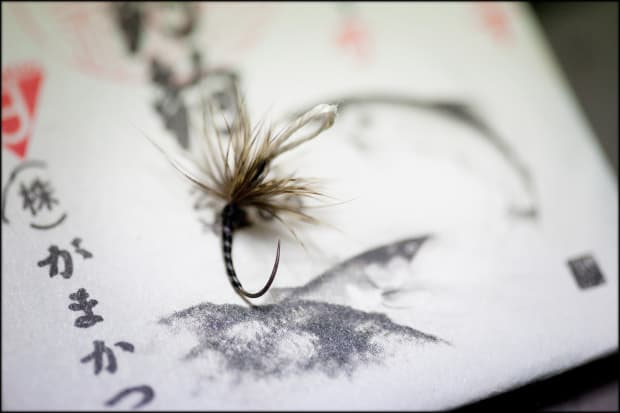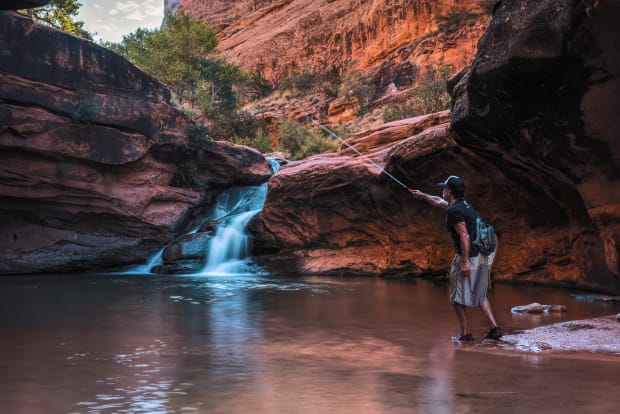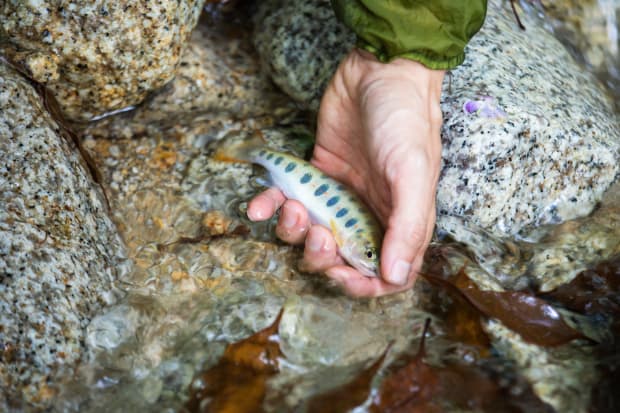Mastering the art of tenkara isn't just about snagging trout without a reel, but embracing the beauty of fly-fishing in its most elemental state.
Anglers up for a more challenging—and arguably more elegant—fishing experience often pivot from traditional spinning rods or baitcasters to fly-fishing. That can be a big jump for most, not just in developing a whole new set of skills for catching fish on a fly, but also budget-wise. Assembling the bare minimum of decent fly-fishing gear can get pricey fast.
A simpler, cheaper method of experiencing the joy and beauty of catching a fish with a fly—regardless of fishing skill—is with a tenkara setup. Newbies will take to this simple style fast, while experienced fly-fishermen seeking something new or just wanting to pare back, can also benefit from a look at tenkara.

Getty
What Is Tenkara Fishing? How Does It Work?
Tenkara is a centuries-old Japanese fishing technique originating in the mountain streams of Japan. Curious what tenkara means in Japanese? It translates to "fishing from heaven" or "sky fishing."
At its core, it’s merely a method of fly-fishing that uses long, lightweight rods and a fixed line (without a reel) to catch fish. It’s kind of like the cane pole fishing many kids grew up doing with a long bamboo rod, a bit of line, and a wriggling worm—but with a smartly designed carbon-fiber rod that telescopes for portability and ease of storage.
Tenkara fishing arguably offers a “purer” and more streamlined fly-fishing experience by just focusing on simple gear and technique while leaving behind the distractions of more complicated equipment. “Taking away the reel and line management aspect of fishing makes it really easy to learn,” says Drew Hollenback, president of Tenkara Rod Co. This simplicity means that anglers can focus on the deceivingly complex essence of fly-fishing: reading the water, selecting the right fly, and making a precise and delicate presentation.
Related: The Best Ultralight Waders and Gear for Backcountry Fly-fishing
“The learning curve isn't as steep as traditional fly-fishing, but the deeper you go into it, the more nuanced it gets," says Hollenback. "Line length, fly selection, casting methods—these are all things that can be improved upon. Tenkara is one of those activities that can be as basic or advanced as you want to make it.”

Getty
What Are the Advantages of Tenkara?
The simplicity of the tenkara kit is its most obvious advantage. That lack of gear makes tenkara angling a more affordable alternative to traditional fly-fishing. Its lightweight design also makes it ideal for those who enjoy fishing in remote areas or on a whim, since it’s easy to have a kit ready to go in your car or stashed in a bag.
“One of the best aspects of tenkara is its portability and just how quickly it is to set up,” says Hollenback. “The rods pack down to 20 inches and extend out to 12 feet and only weigh three ounces. Going from completely collapsed to fishing takes less than a minute."
Tenkara's compactness lends itself extremely well to an assortment of angling-related activities—from backpacking, bikepacking, and hiking to just heading out to fish a spot on the fly without turning it into an all-day event. “Tenkara can be just a fun companion you take with you on other outings—and when you see water, you fish it,” says Hollenback.
Another big advantage to tenkara is how little time it takes to learn the basics. Because there's no reel, you can fish tenkara with one hand without needing to put so much focus into managing all your line. Just look at where you want to place the fly, then figure out how to put it there. “Many people catch fish their first time with a tenkara because it's so intuitive," says Hollenback.
Is Tenkara Easier Than Fly-fishing?
Like with learning anything new, simplicity is relative. Tenkara does pose its challenges that will require some patience and skill to master. Tenkara's long rod and fixed-length line makes it difficult to cast long distances or pull fish from deeper waters. Fishermen must also rely on their ability to read the water, cast accurately, and more precisely manipulate the line to entice fish to swallow their fly.
Another potential tenkara challenge is the limited casting range. Since the rod is fixed in length, anglers need to be in relative close proximity to the fish they want to catch. This requires stealth and patience, as getting too close to the water or making too much noise can easily scare fish away.
Related: America's Backyard: Deep Sea Fishing North Carolina-Style
Arguably, these challenges just add to the beauty of the sport. As any fly-fisherman knows, it's not just about catching fish out there. It’s also about respecting the environment and enjoying the serenity of the experience. To really succeed in tenkara fishing, anglers must be more closely in tune with their surroundings, extra mindful of their actions, and ready to adapt to the always-changing conditions of the water.
Can You Catch Big Fish With Tenkara?
Traditionally, tenkara was used to catch trout in the mountain streams of Japan—and while trout fishing is still tenkara’s main focus, "people are really pushing the limits these days," says Hollenback. "They're catching bass, carp, catfish, salmon, sunfish, and even a variety of saltwater species.”

Getty
Why You Should Try Tenkara
“We've fished with these rods in over 15 countries and several U.S. states, and have caught dozens of different species of fish," says Hollenback, whose favorite thing to do is use fishing as an excuse to explore new places. "Tenkara can take you into areas and zones you normally wouldn't venture into otherwise," he adds.
Last year, Hollenback brought his tenkara rod to the Azores, a small Portuguese island chain in the middle of the Atlantic Ocean. "It's not really a place anyone goes to fly-fish—in fact, we didn't see a single person fishing on our week-long trip," he says. "But we did find some incredible scenery.”
On one day, Hollenback discovered a tiny stream with a huge waterfall overlooking the ocean. At the top of the waterfall, there was a little pool. "We thought no way are there gonna be any fish in this pool, but it'll make for a cool photo," recalls Hollenback, who fished the pool anyway. Sure enough, a little trout came up and ate his fly. "No idea how that fish got there, but also there's no chance we would've ever gone to that spot and had that experience if it wasn't for fishing," he says. "It’s an incredible way to see new places and have unique experiences.”
Get Fishing the Tenkara Way
For an easy, cost-effective entry into tenkara, check out Tenkara Rod Co.'s Sawtooth kit, which provides everything you'll need to get on the water: Sawtooth rod, rod tube, rod sock, 13 feet of tenkara line, three tenkara flies, wood line holder, and 5x tippet. The colorful rod is ideal for fish in the six- to 18-inch range and includes a swivel tip to help prevent your line from getting tangled.
[$195; tenkararodco.com]
from Men's Journal https://ift.tt/s4txqTr


0 comments